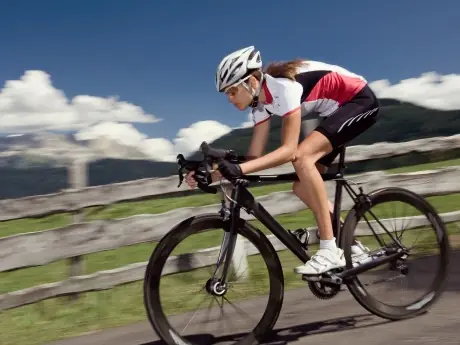Once You're Off
Get out of the saddle and put in a good charge off the line. Try to get up to speed quickly, then settle into the saddle and shift to the gear that will allow a cadence of 80 to 90 rpm. Settle into the drops or aero bars if you have them.
For the first few minutes, get everything under control—your breathing, your position and your cadence. Focus on smooth spinning and be as still as possible in the upper body. Let your legs spin and and hold the bars loosely. Find a rhythm. Don't let a slight incline throw you off and don't shift unless you absolutely have to. Ideally, stay in the same gear and power up and over the incline, staying smooth and low. Don't worry about speeding up yet.
More: 4 Reasons Why Cyclists Should Learn to Relax
Be aware of your HR. After about five minutes, you should be 5 to 7 beats below your threshold HR. If you're too low, shift to the next hardest gear and increase your cadence. If you're too high, back off a bit. Control your breathing. It's not time to be at or above your threshold in the first ten minutes. This is why it's very important to know your threshold HR number. You need to measure your effort correctly in order to save just enough for the rest of the race.
Now you'll begin checking your speed.
Speed Up as You Go
Depending on the length of the TT and the course, at the 10-minute mark you should begin thinking about bumping the effort up a notch. If we stay with the warm up premise that this is a short TT around 20K, the race is going to take a beginner time trialist about 30 minutes to complete. If you ride an average of 24 to 25 mph, you're one-third of the way done. Now it's time to kick it up.
More: 4 Cycling Intervals That Will Make You Faster
Up to this point, you've been maintaining a HR just below your threshold—let's call that low-suffering stage. Now, we want to go into the medium-suffering stage. By that, I mean increasing effort and getting your HR right at threshold.
This is where you will now spend most of your time for the remainder of the race. Speeding up as you go is called negative splitting. You should measure your effort to leave room for just a little bit more suffering, but without blowing up. That's why it's called threshold.
Some TT courses are loops and some are point-to-point. Most are out-and-back courses with an in-road turn around. The turn around is usually marked with an orange cone in the middle of the road signaling the halfway point. This serves as a nice cue for you to ramp the effort a little more, because after the turn around, you're homebound.
More: 3 Drills to Improve Cycling Efficiency and Pedal Cadence
- 4
- of
- 5









Discuss This Article